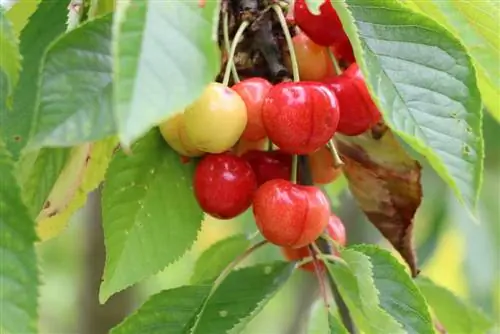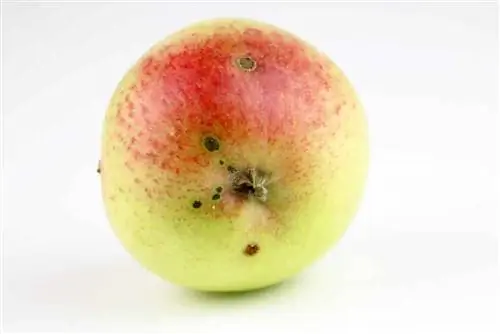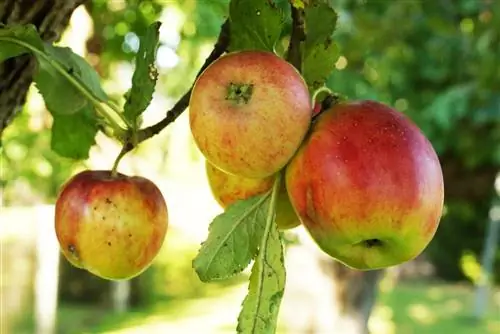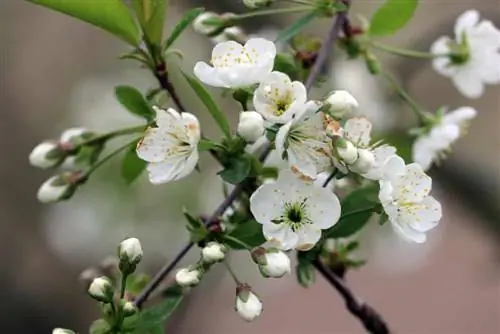- Author admin [email protected].
- Public 2023-12-17 03:39.
- Last modified 2025-01-24 12:45.
As puree, cake or simply fresh - freshly harvested apples from your own garden are a real treat. It's even more annoying when the fruit falls off the tree prematurely. However, that alone is not a reason to worry. The loss of leaves and fruits, however, does. In such cases, it is important to quickly find out what is causing the apple tree to bald prematurely. Otherwise, not just one harvest, but the entire crop is in danger.
June fruit fall
The summer and therefore premature fall of some fruits is by no means a cause for concern. Instead, this is a completely natural and sensible process - especially in productive years. During the so-called June fruit fall, the apple tree drops all those fruits that are insufficiently fertilized, underdeveloped or simply surplus. In this way, the crop ensures that it does not overwhelm itself and overexert itself when caring for and ripening the apples. Or even damage to the apple tree occurs due to the weight of the fruit. So a large amount of fallen fruit in summer is not alarming. However, the fruits of the apple tree should be checked as soon as they are picked. If these show signs of feeding, wormholes, rot on the stem, extreme discoloration or deposits, the leaves of the apple tree should also be examined closely for possible symptoms of disease.
Premature leaf fall
Numerous causes can be responsible for premature leaf fall or an overall bare appearance of the apple tree. Including pathogens such as:
- Leaf drop disease
- Fruit tree spider mite
- Apple scab
However, leaf fall on the apple tree can also be due to a lack of nutrients, drought or an aging plant. It is therefore worth first taking a close look at your previous care and adjusting it if necessary.
Pouring
The formation and ripening of fruits demands a lot from the apple tree. Including a large amount of water. Well-grown fruit trees can usually take care of themselves well. They still suffer in dry periods. When the apple tree bears fruit, it should be watered every now and then. Especially in times of little rain or when there is a lot of fruit on the tree, it is crucial that the substrate never dries out completely. Otherwise, the plant will first separate from the apples and then from the leaves.
Fertilization
Although the apple tree is one of the easy-care and relatively undemanding plants, it still requires regular fertilization. However, it is precisely this additional nutrient supply that is often neglected. Especially in older apple trees, it is crucial for the yield and fruit bearing until ripe. It is ideal to care for the tree at least once a year. For old fruit trees, this can be done twice a year. The supply of nutrients to the apple tree occurs mainly during the first shoots, i.e. in early spring. Fertilization can be carried out again around May.
Complete fertilizers with a high potash content and:are suitable as agents.
- Bluegrain
- Horn meal
- Compost
- Pond water
- Plant manure
- Special fruit tree fertilizer
Blend
Some apple tree varieties tend to become bald as they age. Then hardly any leaves and fruits form anymore. The premature loss of these can be the first indication of aging. An advisable countermeasure here is regular waste. For this purpose, pruning shears should be used once a year. The following will be removed:
- Branches that grow inwards
- Crossing shoots
- Whip shoots, as outgrowths that grow strongly outwards and bend downwards
Branches of the same rank are shortened so that they have approximately the same height and length. This creates the so-called juice scale. In addition, small and young shoots are left on the tree, as this is where the flowers and buds and thus potentially fruits develop. The best time to trim the apple tree is in early spring, around February or March. Ideally, cutting is done when the apple tree has not yet developed any new shoots. However, the measure can also be carried out immediately after the harvest, as long as the cutting falls on a frost-free day.
Tip:
Many people are too timid when it comes to pruning apple trees. Radical shortening and thinning is particularly useful for the fruit tree.
Leaf drop disease
When leaf drop disease occurs, the first thing you notice on the apple tree is dark spots on the leaves. After a certain time, these merge into one another, so that some leaves are completely discolored. The fruits also become dark or even black. Leaf drop disease is particularly common when the summer is very humid, as it is a fungal infection. Fungicides can be used and control the infestation, but there is little chance of a complete cure. Affected plant parts must therefore be removed.
Fruit tree spider mite
The fruit tree spider mite is one of the most important pests on apple trees and can cause considerable damage. Once it has settled on the fruit wood, traces of feeding will appear as white and very fine dots on the leaves. If dark red eggs of the pest appear on the leaves of the apple tree from September onwards, predatory mildew or rapeseed oil can be used to combat them. With oil treatment, the agent is sprayed directly onto the leaves so that the eggs no longer receive oxygen.
Apple scab
Apple scab is also a fungal infection. This causes dark green or gray discoloration on the leaves and buds.
The best prevention is to choose a variety that is resistant to apple scab. Kaiser Wilhelm, Boskop and Renora show little vulnerability. In addition, the leaves should be raked up regularly, removed from the vicinity of the tree and destroyed. Because the fungal spores overwinter in this. The use of fungicides, regular trimming or spraying with wet sulfur can contain the infestation.
Fruit loss
If the apple tree shows an immense loss of fruit, this is usually due to the June fruit fall. Apples that are too heavy and underdeveloped come off the tree just as quickly as apples with insufficient hormone development. The latter do not give the apple tree enough signals to be cared for. As a result, the stem becomes calloused or corked over time and falling off is only a matter of time. However, the care conditions already listed can also be responsible. If the tree does not receive enough water, lacks nutrients or has a rejuvenating trimming, the apples can be discarded at any stage of ripeness. Usually only a few fruits remain on the tree. However, these too are no longer properly cared for, dry out or spoil directly on the easily removable stem. In addition to the care errors mentioned, a pest is almost exclusively the cause of the premature fruit drop. This is the codling moth, whose larvae also damage the apples themselves.
codling moth
The maggots of the codling moth can be found in the buds, bark or unripe apple as long as they are on the apple tree. It can be recognized by drill holes in the fruit, noticeable red discoloration at the feeding and drilling sites and clearly visible fecal residue. When you open the apple, you notice that the larvae have drilled their way into the shell and the inside of the fruit is often already very discolored. Countermeasures are difficult because the adult butterflies usually lay their eggs in the bark and these develop and hatch depending on the temperature. It is therefore difficult to find the appropriate time and the best means of combating it. In addition, the drill holes are quite inconspicuous, which makes countermeasures even more difficult. However, the followingInstructions can help:
- From June to September, the trunk is wrapped in a hood shape with corrugated cardboard. It is best to apply several layers for this. The larvae pupate on the cardboard and can be easily read.
- The cardboard will be completely removed by September at the latest.
- The fruits should be checked regularly for drill holes, larval droppings and any discoloration. If they show such signs, they should be removed and destroyed immediately.
- Since the codling moth's eggs are laid in the bark, this should also be cleaned in the event of a potential infestation. It is then helpful to hose them down every now and then with high water pressure or to scrub them with a hard brush and little pressure. Only loose parts should be removed, but the he althy and firm bark must not be damaged.
Conclusion
If you carry out regular checks and look after the apple tree by watering it as needed, adding fertilizer and rejuvenating trimmings, you rarely have to worry about the harvest. If pests or diseases are the cause of the loss of leaves and fruits, appropriate measures can be taken to combat this.






